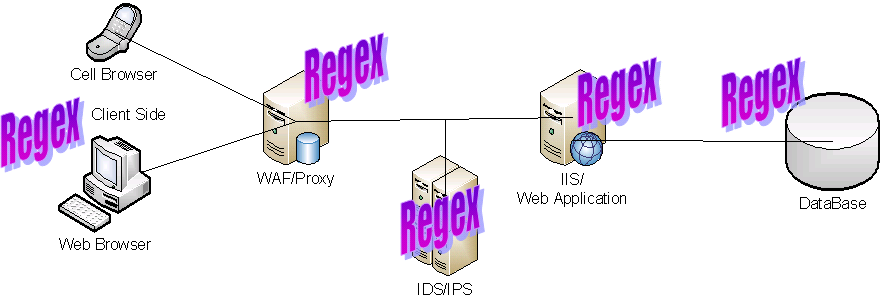Regular expression Denial of Service - ReDoS
Contributor(s): Ebing, Rsl81, Wichers, Bjoern Kimminich, kingthorin, pi3ch
Introduction
The Regular expression Denial of Service (ReDoS) is a Denial of Service attack, that exploits the fact that most Regular Expression implementations may reach extreme situations that cause them to work very slowly (exponentially related to input size). An attacker can then cause a program using a Regular Expression (Regex) to enter these extreme situations and then hang for a very long time.
Description
The problematic Regex naïve algorithm
The Regex naïve algorithm builds a Nondeterministic Finite Automaton (NFA), which is a finite state machine where for each pair of state and input symbol there may be several possible next states. Then the engine starts to make transition until the end of the input. Since there may be several possible next states, a deterministic algorithm is used. This algorithm tries one by one all the possible paths (if needed) until a match is found (or all the paths are tried and fail).
For example, the Regex pattern or quantifier ^(a+)+$ is represented by the following
NFA:

For the input aaaaX there are 16 possible paths in the above
graph. But for aaaaaaaaaaaaaaaaX there are 65536 possible paths,
and the number is double for each additional a. This is an extreme
case where the naïve algorithm is problematic, because it must pass on
many paths to find a non-matching input.
The root-cause of the above example is in a Regex engine feature called backtracking. Simply, if the input (token) fails to match, the engine goes back to previous positions where it could take a different path. The engine tries this many times until it explores all possible paths. In the above example, this feature create a long running loop because there were many paths to explore due to inefficient Regex pattern.
Notice, that not all algorithms are naïve, and actually Regex algorithms can be written in an efficient way. Unfortunately, most Regex engines today try to solve not only “pure” Regexes, but also “expanded” Regexes with “special additions”, such as back-references that cannot be always be solved efficiently (see Patterns for non-regular languages in Wiki-Regex for some more details). So even if the Regex is not “expanded”, a naïve algorithm is used.
Evil Regex
A Regex pattern is called Evil Regex if it can get stuck on crafted input.
Evil Regex contains:
- Grouping with repetition
- Inside the repeated group:
- Repetition
- Alternation with overlapping
Examples of Evil Regex:
(a+)+$([a-zA-Z]+)*$(a|aa)+$(a|a?)+$
All the above are susceptible to the input
aaaaaaaaaaaaaaaaaaaaaaaa! (The minimum input length might change
slightly, when using faster or slower machines).
Attacks
The attacker might use the above knowledge to look for applications that use Regular Expressions, containing an Evil Regex, and send a well-crafted input, that will hang the system. Alternatively, if a Regex itself is affected by a user input, the attacker can inject an Evil Regex, and make the system vulnerable.
Risk Factors
The Web is Regex-Based:

In every layer of the WEB there are Regular Expressions, that might contain an Evil Regex. An attacker can hang a WEB-browser (on a computer or potentially also on a mobile device), hang a Web Application Firewall (WAF), attack a database, and even stack a vulnerable WEB server.
For example, if a programmer uses a Regex to validate the client side of a system, and the Regex contains an Evil Regex, the attacker can assume the same vulnerable Regex is used in the server side, and send a well-crafted input, that stacks the WEB server.
Examples
Vulnerable Regex in online repositories
- ReGexLib,id=1757 (email validation) - see bold part, which is an Evil Regex
^([a-zA-Z0-9])(([\-.]|[_]+)?([a-zA-Z0-9]+))*(@){1}[a-z0-9]+[.]{1}(([a-z]{2,3})|([a-z]{2,3}[.]{1}[a-z]{2,3}))$
Input:
aaaaaaaaaaaaaaaaaaaaaaaa!
- OWASP Validation Regex Repository, Java Classname - see bold part, which is an Evil Regex
^(([a-z])+.)+[A-Z]([a-z])+$
Input:
aaaaaaaaaaaaaaaaaaaaaaaaaaaaaaaaa!
Web application attack
- Open a JavaScript
- Find Evil Regex
- Craft a malicious input for the found Regex
- Submit a valid value via intercepting proxy
- Change the request to contain a malicious input
- You are done!
ReDoS via Regex Injection
The following example checks if the username is part of the password entered by the user.
String userName = textBox1.Text;
String password = textBox2.Text;
Regex testPassword = new Regex(userName);
Match match = testPassword.Match(password);
if (match.Success)
{
MessageBox.Show("Do not include name in password.");
}
else
{
MessageBox.Show("Good password.");
}
If an attacker enters ^(([a-z])+.)+[A-Z]([a-z])+$ as a username
and aaaaaaaaaaaaaaaaaaaaaaaaaaaaaaaaa! as a password, the program
will hang.